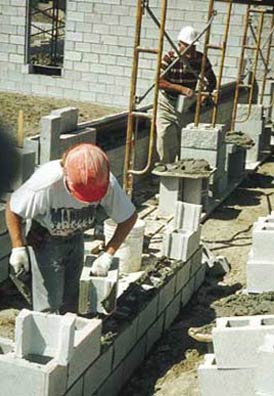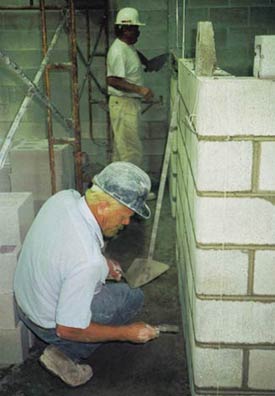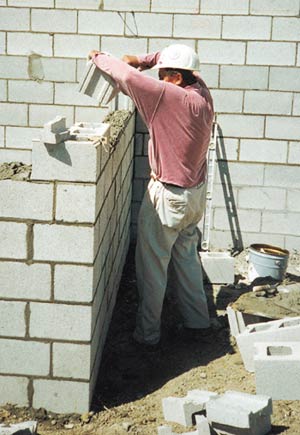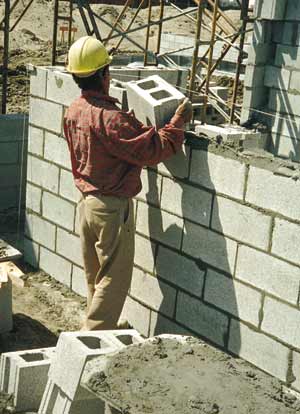Summary Statement
Contractors, government and the Construction Safety Association of Ontario identify activities in the masonry industry that risk causing WMSDs.
1993
Objective
The Ontario Masonry Contractors Association (OMCA) asked that the Workplace Safety and Insurance Board (WSIB) partner with the Construction Safety Association of Ontario (CSAO) to analyze trade activities with a high risk of causing work-related musculoskeletal disorders (WMSDs). These injuries in the masonry trade primarily involve the lower back. There are also work-related problems with shoulder and arm injuries. The WSIB/CSAO study focused on nonresidential jobsites, both indoor and outdoor. The objective was to recommend controls to reduce or eliminate risk factors for WMSDs.

Ergonomics is the study of the body's movements and postures in relation to the performance of a certain task.
The ergonomic analysis of work activities among bricklayers and mason tenders focused on working in awkward postures, lifting, and wrist and arm movements in trowelling.
 |
Masonry workers may bend forward more than 1000 times per shift. This involves lifting not only the block, but also the upper body. In addition, one-handed lifting puts strain on the upper arm, back, and shoulder. Most workers wear gloves when placing block. It is well-documented that wearing gloves reduces the ability to exert gripping force. As a result, the forearm/hand muscles must contract harder than bare hands, contributing to increased fatigue and the risk of incurring a musculoskeletal injury. |
|
Working in constricted spaces imposes awkward postures. Depending on the task, these postures may be sustained for relatively long periods. Constricted areas also force workers to twist when bending, lifting, or placing block. This kind of work carries a very high risk of back injury. The risks of musculoskeletal disorder are similarly high for the shoulder and upper back when blocks are lifted and lowered over and down reinforcing rods. |
 |
In the masonry trade, conditions that carry a high risk of work-related musculoskeletal injuries were identified through site observations and ergonomic analysis.
- Workers often perform more than 1000 forward bending tasks per shift and are therefore at risk of developing low-back disorders.
- Workers who have to lay brick and block above shoulder height increase their risk of developing shoulder, arm, and wrist problems.
- Masonry workers are exposed to environmental factors such as wind and excessive heat and cold. Walking or working on uneven, muddy, or icy surfaces exposes bricklayers and mason tenders to the risk of slips, trips, and falls.
- Workers generally use large trowels (12-inch) that enable them to lay more mortar per application but also increase the risk of elbow and wrist injuries.
- Many workers wear gloves when lifting and placing block. Gloves actually reduce grip strength.
- Mortarboards are typically positioned at or below knee level. This forces workers to bend forward repetitively -- a contributing factor to low-back disorders.
- Bricklayers often work in restricted spaces where their freedom of movement is limited. As a result they must adopt awkward, twisting movements when lifting and laying brick and block. This increases the risk of musculoskeletal injury.
- The stress of maintaining the expected production rate (about 200 blocks or 600 bricks per day) can lead to muscle tension and greater likelihood of injury.

Working
against gravity in this awkward posture creates high musculoskeletal
loads and reduces blood flow to muscle and other tissue. The posture
requires that the muscles of the upper shoulder and back lengthen
while they also contract. At the same time, forearm and hand muscles
must be held in a contracted position to maintain grip on the
block while it is being carefully lowered. All of this muscle
activity in an awkward posture requires high energy expenditure
and causes fatigue.
 |
Working against gravity in this awkward posture creates high musculoskeletal loads and reduces blood flow to muscle and other tissue. The posture requires that the muscles of the upper shoulder and back lengthen while they also contract. At the same time, forearm and hand muscles must be held in a contracted position to maintain grip on the block while it is being carefully lowered. All of this muscle activity in an awkward posture requires high energy expenditure and causes fatigue. |
This mason
is working on the same wall as his taller partner in the photo
at left. But he employs a better technique, reducing significantly
the musculoskeletal risk factors in laying block.
The mortarboards,
however, could be raised higher. Mortarboards are typically
set at or below knee level, forcing workers to bend forward
in order to load their trowels. Repetitive forward bending is
a contributing factor to musculoskeletal back injuries.

|
This mason is working on the same wall as his taller partner in the photo at left. But he employs a better technique, reducing significantly the musculoskeletal risk factors in laying block. The mortarboards, however, could be raised higher. Mortarboards are typically set at or below knee level, forcing workers to bend forward in order to load their trowels. Repetitive forward bending is a contributing factor to musculoskeletal back injuries. |
 |
Results
After conducting and reviewing this ergonomic study of the masonry trade, representatives of the OMCA, WSIB, and CSAO agreed that corrective action is not only possible but necessary.
The first step is for both management and labor to recognize that risk factors exist. The next step is to work toward controlling or eliminating those factors.
Correction requires commitment and continuous improvements at various levels of a company, with attention not only to specific job tasks but to the structuring and supervision of work and the development of appropriate policies and procedures. A systematic approach can help to reduce both injury rates and compensation costs.
RecommendationsSpecific recommendations of the study include the following:
- Develop information and training on trade-specific ergonomic practices, including work pacing.
- Identify best practices to reduce injuries and increase efficiency -- for instance, mast-climbing work platforms.
- Implement a pre-job exercise program and improve work/rest cycles to reduce fatigue and injury.
- Plan and organize sites to facilitate access, reduce unnecessary materials handling, and avoid work in constricted spaces that force workers into awkward postures and twisting movements.
- Use height-adjustable mortarboards to reduce forward bending. Similarly, keep platforms for stocking brick and block no lower than knee-height.
- Educate workers regarding the importance of using a trowel suited to their individual size and strength.
- Work with manufacturers to develop more ergonomically favorable bricks and blocks.
These recommendations are meant to help eliminate or reduce risk factors surrounding work-related musculoskeletal disorders in the masonry trade.
The recommendations are only a starting point. Further development and implementation should involve those directly concerned -- Ontario's bricklayers and mason tenders.


